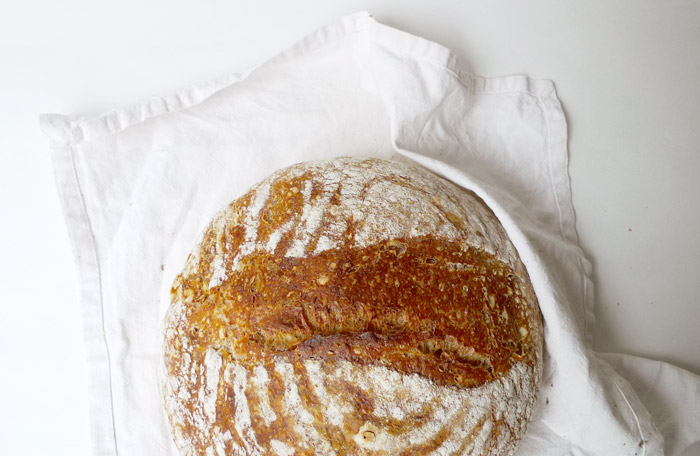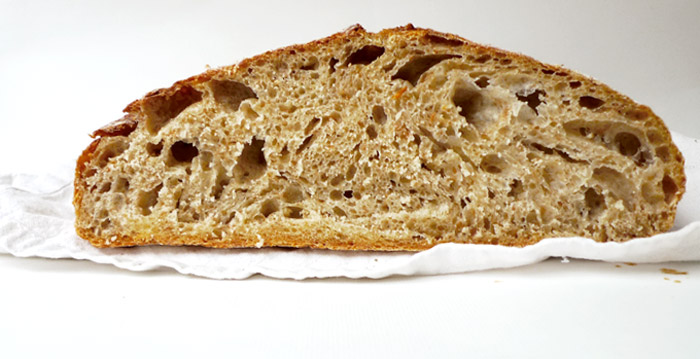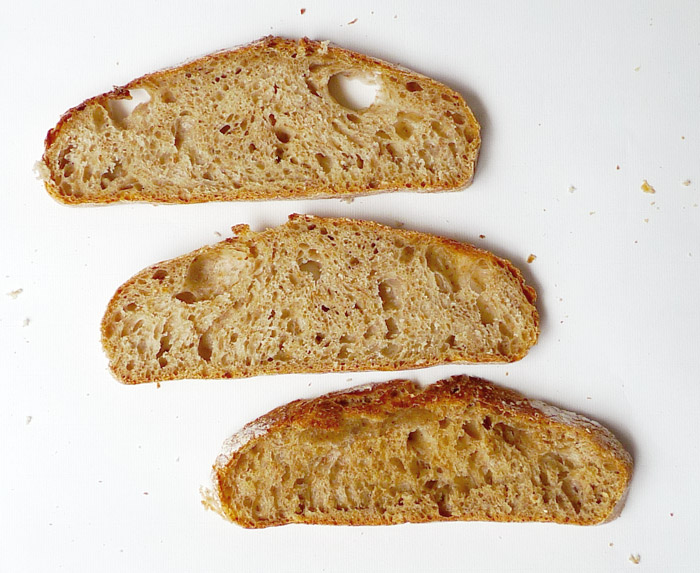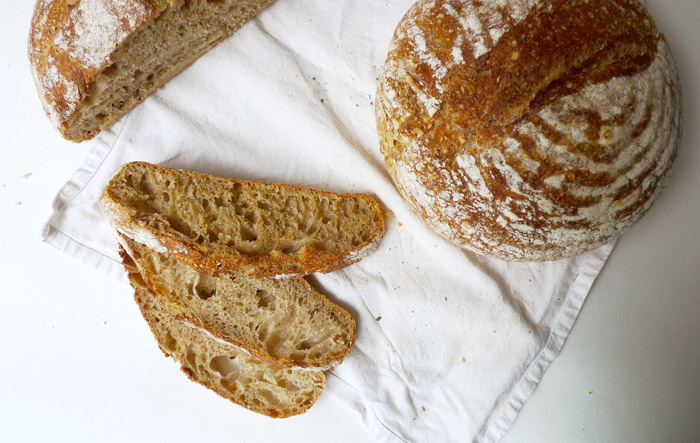

[tp lang=”es” only=”y”] Ya toca una de pan. He de reconocerlo, estoy obsesionada con el pan de Tartine… y como no. Nunca lo he visto en vivo, pero esas migas y esas cortezas me tienen enamorada. Así que como soy un poco cabezota he decidido que quiero hacer ese pan hasta que salga perfecto o lo mejor posible (dentro de mis posibilidades). Así que llevo luchando con él unas cuantas veces y creo que nos empezamos a hacer amigos. Este finde ha salido uno que me tiene más que contenta! No suelo poner recetas de panes porque es un tema más complicado y este blog es de cosas sencillas y fáciles pero, esta vez os copio la receta del libro y os cuento un poco como lo hice yo.[/tp]
[tp lang=”es” only=”y”]Esta es la receta del country loaf de trigo blanco. Es un pan sólo de masa madre por lo que que necesitaréis estar familiarizados con la masa madre y tenerla activa. La mía está alimentada con centeno integral.[/tp]
[tp not_in=”es”]It´s bread time. I have to admit, I’m obsessed with Tartine´s Bread. I haven´t tried it or seen it (besides the book I mean) but those crumbs and crusts keep me in love. So, since I am a bit stubborn I’ve decided I want to make this bread until it is perfect or at least the best I can. So I’ve been struggling with it a few times and I think we have started to become friends. This weekend I made one which has left me more than happy! I usually don´t put bread recipes here because it is a complicated issue and this blog is for simple and easy things, but… this time I copied the recipe from the book and I’ll tell you a little of how I did it.[/tp]
[tp not_in=”es”]This is the recipe for the white country loaf. It’s a sourdough bread just so you will need to be familiar with sourdough and have it active. Mine is fed with whole rye.[/tp]
[tp lang=”es” only=”y”]Ingredientes
- agua 26ºc 700grs + 50 grs.
- masa madre activa (que flote) 200 grs.
- Harina panadera trigo 900grs.
- Harina integral trigo 100grs.
- sal 20grs.
Bueno más que una receta, os cuento lo que hice. Primero en un bowl muy grande mezclar la masa madre (primero que pase la prueba de la flotabilidad) con 700 grs. de agua a 26ºc La batí un poco para deshacerla y luego añadir las harinas que son en total 1k. Mezclamos bien y dejamos reposar unos 45 minutos. Pasado este tiempo añadir la sal y los 50grs. de agua restantes, mezclar muy bien y amasar un poco en el bowl. La tapamos con un trapo húmedo y la dejamos 30 minutos. He seguido el sistema del libro de ir plegando varias veces dentro del mismo bowl. Así que a los 30 minutos la plegamos sobre si misma, lo que suelo hacer es plegarla por uno de sus lados e irla rotando y plegando hasta hacer cuatro pliegues.
Así las primeras 2 horas:
pliegue- 30 min. descanso
Después de las 4 veces de pliegue-descanso de 30 minutos (en total 2 horas) pasamos a dejarla reposar una hora y luego otro pliegue y descanso de otra hora. En total el tiempo de plegados más o menos es de 4 horas. Aquí le puse un plástico por encima al bowl y la metí a la nevera a fermentar toda la noche,ya que la quería hornear al día siguiente.
Al día siguiente la saqué, la dejé un rato para que se atemperará y la dividí en dos. Las dos masas las plegue sobre si mismas y las dejé reposar unos 30 min. Formarlas en bola y cada una a su banetón a descansar, como a las dos horas las horneé. En la cocotte, como dice en el libro. Esta masa es muy húmeda y la he intentado hornear sin cocotte alguna vez y ha sido un desastre total así que me quedo con la cocotte para este pan, 25 minutos con tapa y unos 25 sin tapa hasta que tenga el color que queremos! Esta vez ha salido bastante bien (aunque no perfecto, esas greñas como que no) con lo cual de momento seguiremos practicando![/tp]
[tp not_in=”es”]Ingredients
- water 80ºF 700grs + 50 grs.
- leaven (floating) 200 grs.
- White flour 900grs.
- wholemeal wheat flour 100grs.
- salt 20grs.
Well more than a recipe, I´ll tell you what I did. First in a large bowl mix the sourdough (first pass the floating test) with 700 grs. of water at 80°F beat slightly to undo it and then add the flours which are a total of 1k. Mix well and let it stand about 45 minutes. After this time, add salt and 50g. of remaining water. Mix well and knead a little in the bowl. Then cover with a damp cloth and let stand for 30 minutes. I followed the book system of folding several times within the same bowl. So after 30 minutes, fold it over itself, what I do is fold by one side and then rotate it and fold again until you make four folds.
Thus the first 2 hours:
fold- 30 min. rest
After 4 series of “fold and 30 rest minutes” which sum 2 hours, let it sit an hour and then give it another fold and rest for another hour. In total the folding time is roughly 4 hours. Here I put a plastic cover on the bowl and stuck it into the fridge to ferment overnight since I wanted to bake the next day.
The next day I took it out, I left it for a while outside so it would temper and then divided it into two. I folded the two doughs on themselves and let them stand for 30 min. Then I formed them in a boule and put them in their baskets to rest for sort of two hours. Then I baked them in the Dutch oven as it says in the book. This dough is very wet and I´ve tried baking it without the dutch oven and it has been a total disaster. So for this bread I prefer to use it, 25 minutes with a lid and 25 without lid until you have the color you want! This time it turned out pretty well (although not perfect, the scorings are not so good) So I´ll just have to continue practicing![/tp]




One reply on “Exploraciones panaderas: El pan de tartine”
Toma pan!! Que pasada…tiene un aspecto riquísimo…a la que consiga tener masa madre lo hago….hasta el día de hoy no hay forma de conseguir hacer masa madre….y claro con levadura supongo no será lo mismo…eres una artista del pan…;) besos